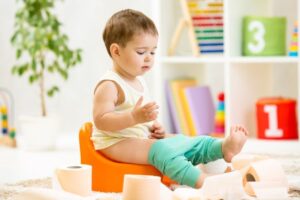SHARE WITH FRIENDS:
When should you start potty training a child?
The most important aspect of teaching a child to use the toilet independently is that the child knows how often to defecate. We adults, who want to train the child to the potty as soon as possible, regardless of his will, prevent the child from observing the changes in the urinary tract. It is normal for the child to wet his diaper several times and feel uncomfortable. Although the optimal time for potty training, i.e. potty training, is 18 months, it depends on the individual condition of each child's organism. In order to know when it is time to teach the child to use the toilet independently, it is necessary to observe the behavior of the child. For example, many children stand up when defecating. Children usually defecate while walking, but when they gain control of their urinary tract muscles, they do not walk, but instead stand, wait, defecate, and continue walking again. When the child wants to defecate, he goes to his parents or hides somewhere and continues his work only after defecating. You can easily notice that it is time to potty train the child by this movement.
Only after that you can follow the 3-day rule.
So what is the three day rule?
This is a test rule. Accordingly, on the first day, you should use a cloth diaper that does not absorb moisture, not a disposable diaper that absorbs any liquid and keeps the baby's bottom dry. Because when the child feels moisture, it makes him feel uncomfortable, then he is forced to give some kind of sign to get rid of it. This obligation helps to prevent this moisture and, as a result, to form the skill of sitting on the potty. If you wear disposable diapers that absorb moisture well and provide comfort to the child, the need for independent toileting will decrease.
Therefore, on the first day of training, the child should use a reusable cloth diaper that can feel the discomfort of moisture. Then the child feels the discomfort of wetness and gradually begins to use the muscles of the urinary tract.
On the second day, the cloth should be completely removed. Offer the child "if you want, I won't put on another diaper for you." Wear panties or panties, not cloth diapers. When the child defecates on his clothes, he feels the discomfort of getting wet more and starts looking for a solution for this discomfort.
On the third day, they begin to produce their solutions. Some children may not fully understand what is happening. In this situation, come to him and say, "You don't like this situation, right, come, then we'll sit on the potty, so your bottom won't get wet, if you want, I'll help you," offer him your help. do it
